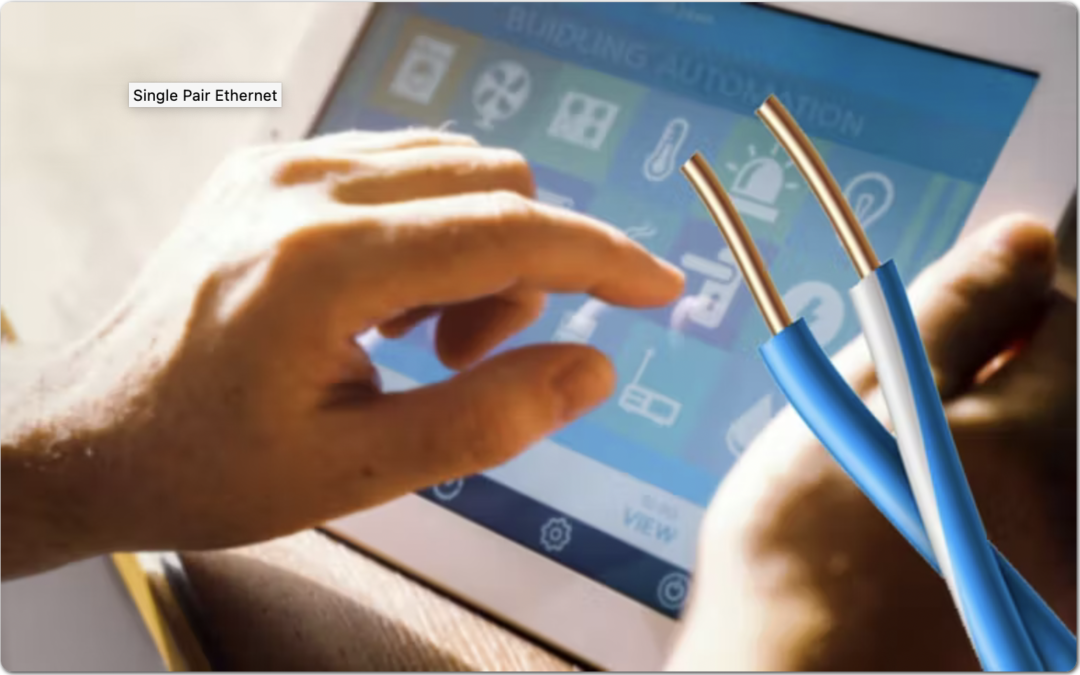From automobile to automation
SPE isn’t a new technology. Completed standards that have existed since 2015 are targeted toward much shorter-reach engineered links in automobiles and industrial systems. SPE standards for those environments continue to evolve, and while unrelated to smart buildings, it’s easy to correlate the benefits of Ethernet in an automobile to benefits in a smart building. With modern vehicles equipped with numerous smart technologies including driving aids, systems that previously communicated internally using their own language now need to communicate with other systems inside the vehicle, to make decisions as quickly and efficiently as possible—like when the system that detects your car is too close to something in front of you must communicate with the braking system.
The primary use for SPE for smart building automation is for connecting low-speed operational technology (OT) devices like controllers and actuators, sensors, and meters used in HVAC, air quality, waste management, lighting, security, and other building control systems. Just like in a car, the use of Ethernet as a common language allows for communication and sharing of actionable data across these systems to more easily make decisions that improve efficiency and occupant experience. Rather than the line-of-sight sensor in a car talking to the brakes, it’s the occupancy sensor in the conference room talking to the HVAC system. Because OT smart building devices typically don’t require the gigabit and multi-gigabit Ethernet speeds needed for IT devices and supported by four-pair cabling, SPE is an optimized solution for reducing cost and material, while still bringing the benefits of Ethernet communication to building systems. While much of the demand for SPE can be attributed to the automotive and industrial industry, a study published recently by The Insight Partners predicts that the SPE market will reach $3.6 billion by 2028, up from $1.9 in 2021, and specifically mentions real-time monitoring and smart building devices among the market’s drivers.
“Customers are asking building automation system vendors for more Ethernet. It’s a huge smart building enabler that makes data easily transportable, translatable, and more secure,” says Bob Voss, chair of the SPE Subcommittee of the Beaverton, OR-based Ethernet Alliance and distinguished engineer for Panduit, which is based in Tinley Park, IL and manufacturers infrastructure components. “Traditional purpose-built disparate systems with their own protocols create a business continuity risk since they are more vulnerable to cyberattack, and the bulk of those that support these systems are nearing retirement. By bringing Ethernet out to the edge of the OT network, these devices can leverage the IT expertise of the many who already know how to secure, maintain, and troubleshoot Ethernet networks—all while providing a common language for building systems to better communicate.”
Potential plug-and-play building blocks
While application standards have been available for more than two years, SPE component standards for the commercial environment were published by international standards bodies ISO (Geneva, Switzerland), IEC (Geneva, Switzerland), and CENELEC (Brussels, Belgium) in late 2020. The recently released North American TIA-568.5 SPE component standard specifications are in alignment with international standards. Now the frequently asked question is: when will SPE-capable building automation devices be available in the marketplace?
“The application is available, and smart building device manufactures will hopefully be integrating SPE technology into their chipsets soon,” says Valerie Maguire, distinguished engineer for Watertown, CT-based Siemon and chief editor of the IEEE Std 802.3cg™-2019 Single-Pair Ethernet amendment. “Many building automation devices have traditionally used screw terminals to make connections, but with SPE component standards now available, we’re looking forward to device manufacturers eventually adopting the I/O interface that accepts an SPE plug. The upside potential for plug-and-play connectivity to connect these devices is for faster and more reliable smart building deployments. There is also the potential to better integrate IT and OT systems with familiar four-pair cables in the backbone infrastructure, leading to integration of both Ethernet networks. In fact, the existing installed base of Siemon’s fully shielded four-pair TERA® cabling is proven to support 10 Mb/s SPE applications over up to 400 meters and can be leveraged for future support of SPE connections.”
Voss too sees the benefits of plug-and-play capability eventually hitting the market to support smart building deployments. “There is always the potential for workmanship issues when using screw terminal connections—wires becoming untwisted or the potential for a strand to touch an adjacent terminal. And as speeds increase, terminal strips will become a source of loss and noise that will be intolerable,” he says. “Plus, IT is used to dealing with connectorized components, and the more they get involved on the OT side, the more they’re going to demand plug and play.”
According to Voss, SPE and its interface is on the roadmap of building automation device vendors including Johnson Controls and Honeywell, and he is excited about its potential to change how we construct buildings. “With OT systems now shifting to Ethernet and leveraging IT infrastructure, technology will no longer be an afterthought in new building design,” he says. “There will however be a bit of speed bump when it comes to retrofitting existing buildings that have traditional disparate and yet functioning building systems, and we’re going to need to help them make that migration.”
This article originally appeared in the March 2022 issue of Smart Buildings Technology.

